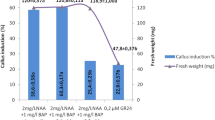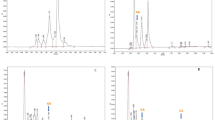Abstract
To study biosynthetic abilities of Lithospermum officinale, callus formation from young leaves and stems of the plant was induced on Linsmaier-Skoog medium supplemented with 2,4-D (10−6 M) and kinetin (10−5 M). Maintaining the calli on this medium resulted in polyphenolic compounds production. Their transfer onto White medium containing IAA (10−7 M) and kinetin (10−5 M) resulted in the production of a red naphthoquinonic pigment named shikalkin. Shikalkin production from callus cultures was suppressed on the White medium containing NAA instead of IAA. This observation indicates that both shikalkin and polyphenolic acids biosynthetic pathways exist in the L. officinale callus cells and a regulatory system counterbalances the ratio of shikalkin to polyphenolic acids.
Similar content being viewed by others
References
Agata, I., Tsutomu, H., Nishibe, S. & Okuda, T. 1989. A tetrameric derivative of caffeic acid from Rabdosia japonica. Phytochem. 28: 2447–2450.
Chen, F.A., Cheng, H.W., Wu, A.B., Hsu, H.C. & Chen, C.Y. 1996. Kinetic studies of the photochemical decomposition of Alkannin/Shikonin enantiomers. Chem. Pharm.Bull. 44: 249–251.
Chen, J.H. & Ho, C.T. 1997. Antioxidant activities of caffeic acid and its related hydroxycinnamic acid compounds. J. Agric. Food Chem. 45: 2374–2378.
De-Eknamkul, W. & Ellis, B.E. 1984. Rosmarinic acid production and growth characteristics of Anchusa officinalis cell suspension cultures. Planta Medica 25: 346–350.
Fujita, Y., Hara, Y., Ogino, T. & Suga, C. 1981a. Production of shikonin derivatives by cell suspension cultures of Lithospermum erythrorhizon. I. Effects of nitrogen sources on the production of shikonin derivatives. Plant Cell Rep. 1: 59–60.
Fujita, Y., Hara, T., Suga, C. & Morimoto, T. 1981b. Production of shikonin derivatives by cell suspension cultures of Lithospermum erythrorhizon. II. A new medium for the production of shikonin derivatives. Plant Cell Rep. 1: 61–63.
Gaisser, S. & Heide, L. 1996. Inhibition and regulation of shikonin biosynthesis in suspension cultures of Lithospermum. Phytochem. 41: 1065–1072.
John, M., Gumbinger, H. & Winterhoff, H. 1990. Oxidation products of caffeic acid as model substances for the antigonadotropic activity of plant extracts. Planta Medica 56: 14–18.
Kelley, C.J., Mahajan, J.R., Brooks, L.C., Neubert, L.A., Breneman, W.R. & Carmack, M. 1975. Polyphenolic acids of Lithospermum ruderale. Isolation and structure determination of lithospermic acid. J. Org. Chem. 40: 1804–1815.
Khan, H.A., Chandrasekharan, I. & Ghanim, A. 1983. Naphthazarins from Arnebia hispidissima. Phytochemistry 22: 614–615.
Maloney, V. 2004. Plant metabolomics. BioTeach J. 2: 92–99.
Matsuno, M., Nagatsu, A., Ogihara, Y. & Mizukami, H. 2001. Synthesis of 2-0-(4-coumaroyl)-3-(4-hydroxy phenyl) lactic acid, an important intermediate of rosmarinic acid biosynthesis. Chem. Pharm. Bull. 49: 1644–1646.
Mizukami, H., Tabira, Y. & Ellis, B. 1993. Methyl jasmonate-induced rosmarinic acid biosynthesis in Lithospermum erythrorhizon cell suspension cultures. Plant Cell Rep. 12: 706–709.
Mizukami, H., Ogawa, T., Ohashi, & H. Ellis, B. 1992. Induction of rosmarinic acid biosynthesis in Lithospermum erythrorhizon cell suspension cultures by yeast extract. Plant Cell Rep. 11: 480–483.
Nahrstedt, A., Albrecht, M., Wray, V., John, M., Winterhoff, H. & Kemper, F. 1990. Structure of compounds with antigonadotropic activity obtained by in vitro oxidation of caffeic acid. Planta Medica 56: 395–398.
Papageorgiou, V.P., Assimopoulou, A.N., Couladouros, E.A., Hepworth, D. & Nicolaou, K.C. 1999. The chemistry and biology of alkannin, shikonin, and related naphthazarin natural products. Angew. Chem. Int. Ed. 38: 270–300.
Shukla, Y.N., Tandon, J.S., Bhakuni, D.S. & Dhar, M.M. 1971. Naphthaquinones of Arnebia Nobilis. Phytochem. 10: 1909–1915.
Srinivasan, V. & Ryu, D.D.Y. 1993. Improvement of shikonin productivity in Lithospermum erythrorhizon cell culture by alternating carbon and nitrogen feeding strategy. Biotech. Bioeng. 42: 793–799.
Tanaka, T., Morimoto, S., Nishioka, I., Yokozawa, T. & Oura, H. 1989. Magnesium and ammonium-potassium Lithospermates B, the active principles having a uremia-preventive effect from Salvia miltiorrhiza. Chem. Pharm. Bull. 37: 340–344.
Tanaka, S., Tajima, M., Tsukada, M. & Tabata, M. 1986. A comparative study on anti-inflammatory activities of the enantiomers, shikonin and alkannin. J. Natural Products 49: 466–469.
Van Der Vijver, L.M. & Gerritsma, K.W. 1975. Behavior of 7-methyljuglone and two related naphthoquinones on silica gel exposed to air. J. Chromatography 114: 443–450.
Williams, D.H. & Fleming, I. 1980. Spectroscopic methods in organic chemistry, 3rd ed. McGraw-Hill Book Company (UK), pp. 22–31.
Winterhoff, H., Gumbinger, H. & Sourgens, H. 1988. On the antigonadotropic activity of Lithospermum and Lycopus species and some of their phenolic constituents. Planta Medica 23: 101–106.
Winterhoff, H., Sourgens, H. & Kemper, F.H. 1983. Antihormonal effects of plant extracts. Pharmacodynamic effects of Lithospermum officinale on the thyroid gland of rats; comparison with the effects of iodide. Hormone Metabolism Research. 15: 503–507.
Xu-Qing, F. & De-Wei, L. 1999. Stimulation of shikonin production by combined fungal elicitation and in situ extraction in suspension culture of Arnebia euchroma. Enzyme Microb. Technol. 24: 243–246.
Yamamoto, H., Inoue, K. & Yazaki, K. 2000. Caffeic acid oligomers in Lithospermum erythrorhizon cell suspension cultures. Phytochem. 738: 3–15.
Yamamoto, H., Zhao, P., Yazaki, K. & Inoue, K. 2002. Regulation of lithospermic acid B and shikonin production in Lithospermum erythrorhizon cell suspension cultures. Chem. Pharm. Bull. 50: 1086–1090.
Yazaki, K., Fukui, H., Nishikawa, Y. & Tabata, M. 1997. Measurement of phenolic compounds and their effect on shikonin production in Lithospermum cultured cells. Biosci. Biotech. Biochem. 61: 1674–1678.
Author information
Authors and Affiliations
Corresponding author
Rights and permissions
About this article
Cite this article
Haghbeen, K., Mozaffarian, V., Ghaffari, F. et al. Lithospermum officinale callus produces shikalkin. Biologia 61, 463–467 (2006). https://doi.org/10.2478/s11756-006-0077-x
Received:
Accepted:
Issue Date:
DOI: https://doi.org/10.2478/s11756-006-0077-x




